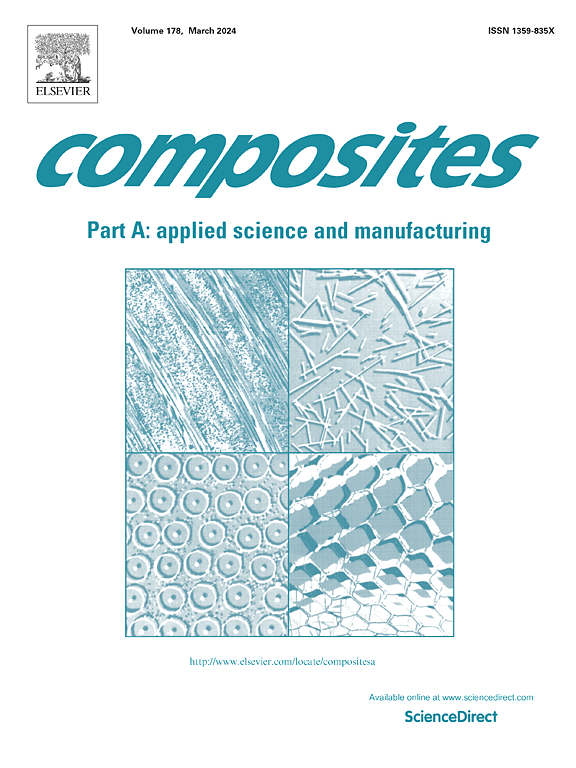Lightweight nano-metallized wood: Toward high-performance electromagnetic interference shielding with multifunctional attributes
IF 8.1
2区 材料科学
Q1 ENGINEERING, MANUFACTURING
Composites Part A: Applied Science and Manufacturing
Pub Date : 2025-05-09
DOI:10.1016/j.compositesa.2025.109012
引用次数: 0
Abstract
The proliferation of electronic devices has heightened the demand for effective electromagnetic interference (EMI) shielding materials with lightweight and sustainable properties. This study presents the development of lightweight, nano-metallized wood with superior EMI shielding effectiveness, water repellency, and infrared shielding capabilities. Balsa wood was subjected to magnetron sputtering to deposit ultra-thin Cu and Ni metal films, achieving a total thickness of 100 nm. The Cu-Wood-Cu (Cu-W-Cu) structured material demonstrated the highest EMI shielding performance, with an average shielding effectiveness of 31.73 dB, surpassing commercial requirements. The material’s hydrophobicity was significantly enhanced, with water contact angles reaching up to 103.2°, attributed to the increased surface roughness. Infrared shielding performance was also notable, with the Cu-W-Cu material reflecting a majority of incident infrared radiation, reducing the surface temperature by 36.9 °C compared to the heating source. The study elucidates the material’s potential in practical EMI shielding applications, showcasing its effectiveness in blocking electromagnetic signals from a Tesla coil and mobile phone signals. The findings underscore the promise of these sustainable, lightweight wood-based materials in addressing multifaceted protection needs, including EMI shielding, water resistance, and thermal management.
轻质纳米金属化木材:向多功能高性能电磁干扰屏蔽方向发展
随着电子设备的不断发展,对具有轻量化和可持续性能的有效电磁干扰屏蔽材料的需求日益增加。这项研究展示了轻质、纳米金属化木材的发展,具有优异的电磁干扰屏蔽效果、拒水性和红外屏蔽能力。对巴尔沙木进行磁控溅射,沉积超薄的Cu和Ni金属膜,总厚度达到100 nm。Cu-Wood-Cu (Cu-W-Cu)结构材料显示出最高的EMI屏蔽性能,平均屏蔽效率为31.73 dB,超过了商业要求。由于表面粗糙度的提高,材料的疏水性显著增强,水接触角达到103.2°。红外屏蔽性能也很显著,Cu-W-Cu材料反射了大部分入射红外辐射,与热源相比,表面温度降低了36.9℃。这项研究阐明了这种材料在实际电磁干扰屏蔽应用中的潜力,展示了它在阻挡来自特斯拉线圈和手机信号的电磁信号方面的有效性。研究结果强调了这些可持续的轻质木质材料在解决多方面保护需求方面的前景,包括电磁干扰屏蔽、防水和热管理。
本文章由计算机程序翻译,如有差异,请以英文原文为准。
求助全文
约1分钟内获得全文
求助全文
来源期刊

Composites Part A: Applied Science and Manufacturing
工程技术-材料科学:复合
CiteScore
15.20
自引率
5.70%
发文量
492
审稿时长
30 days
期刊介绍:
Composites Part A: Applied Science and Manufacturing is a comprehensive journal that publishes original research papers, review articles, case studies, short communications, and letters covering various aspects of composite materials science and technology. This includes fibrous and particulate reinforcements in polymeric, metallic, and ceramic matrices, as well as 'natural' composites like wood and biological materials. The journal addresses topics such as properties, design, and manufacture of reinforcing fibers and particles, novel architectures and concepts, multifunctional composites, advancements in fabrication and processing, manufacturing science, process modeling, experimental mechanics, microstructural characterization, interfaces, prediction and measurement of mechanical, physical, and chemical behavior, and performance in service. Additionally, articles on economic and commercial aspects, design, and case studies are welcomed. All submissions undergo rigorous peer review to ensure they contribute significantly and innovatively, maintaining high standards for content and presentation. The editorial team aims to expedite the review process for prompt publication.
 求助内容:
求助内容: 应助结果提醒方式:
应助结果提醒方式:


